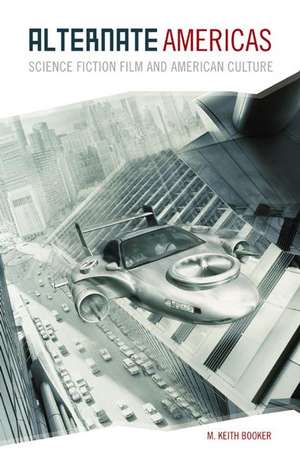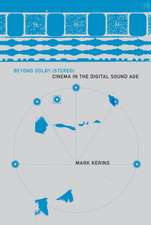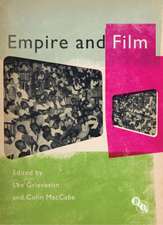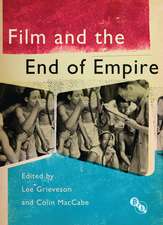Alternate Americas: Science Fiction Film and American Culture
Autor Prof. M. Keith Bookeren Limba Engleză Hardback – 27 feb 2006 – vârsta până la 17 ani
Preț: 357.89 lei
Preț vechi: 416.35 lei
-14% Nou
Puncte Express: 537
Preț estimativ în valută:
68.48€ • 71.68$ • 56.100£
68.48€ • 71.68$ • 56.100£
Carte tipărită la comandă
Livrare economică 31 martie-14 aprilie
Preluare comenzi: 021 569.72.76
Specificații
ISBN-13: 9780275983956
ISBN-10: 0275983951
Pagini: 296
Ilustrații: 1
Dimensiuni: 152 x 229 x 28 mm
Greutate: 0.61 kg
Editura: Bloomsbury Publishing
Colecția Praeger
Locul publicării:New York, United States
ISBN-10: 0275983951
Pagini: 296
Ilustrații: 1
Dimensiuni: 152 x 229 x 28 mm
Greutate: 0.61 kg
Editura: Bloomsbury Publishing
Colecția Praeger
Locul publicării:New York, United States
Notă biografică
M. Keith Booker is Professor and Director of Graduate Studies in the Department of English at the University of Arkansas. He is the author of numerous articles and books on modern literature, film, and science-fiction, including Film and the American Left (1999), Monsters, Mushroom Clouds, and the Cold War (2001), Strange TV: Innovative Television Series from The Twilight Zone to The X-Files (2003), and Science Fiction Television (2004).
Cuprins
IntroductionThe Day the Earth Stood StillForbidden PlanetInvasion of the Body Snatchers2001: A Space OdysseyPlanet of the ApesStar WarsClose Encounters of the Third KindAlienE.T. the Extra-TerrestrialBlade RunnerThe TerminatorRobocopThe AbyssIndependence DayThe MatrixConclusionNotesIndex
Recenzii
.ideally suited for general readers looking for a new perspective on familiar texts and for instructors looking for accessible analyses of how films reflect their historical and cultural contexts.
Booker studies 15 science fiction films made in the US in the second half of the 20th century, including The Day the Earth Stood Still (1951), 2001: A Space Odyssey (1968), Blade Runner (1982), and The Matrix (1999). The 25-page introduction reveals the author's extensive knowledge of his subject; here Booker looks at historical events that affected the production of certain types of films, e.g., the Cold War and the alien-invasion films. He then devotes a chapter to each film, providing for each a one-paragraph introduction; sections on the plot and the sources of the film; a longer discussion of how events in society contributed to certain concerns of the film and elements of the production; and a concluding section on how that film influenced other films.. Recommended. Lower-/upper-division undergraduates; general readers.
M. Keith Booker, the author of several studies of film and television, offers a guide to the leading science fiction movies since the 1950s. Each of his chapters is devoted to a film -- fifteen in total -- and follows the pattern of plot summary, note on sources, interpretation, and indication of the work's legacy. The summaries are helpful and clear but the interpretive commentary will probably be of more interested to the reader because in every case Booker relateds the films to their cultural context.
College-level collections strong in science fiction holdings will welcome the scholarly survey Alternate Americas: Science Fiction Film and American Culture. Its professor author M. Keith Booker has selected some fifteen of the most successful, innovative sci fi films of all time and here considers their cultural, technical and cinematic effects. Any genre fan will immediately recognize and acknowledge these selections as true 'greats', from Forbidden Planet and 2001 to Alien, E.T., Blade Runner and Matrix. That they not only reflected future fantasy but the concerns and culture of their times makes for a penetrating analysis which surveys plots and underlying meanings.
Booker studies 15 science fiction films made in the US in the second half of the 20th century, including The Day the Earth Stood Still (1951), 2001: A Space Odyssey (1968), Blade Runner (1982), and The Matrix (1999). The 25-page introduction reveals the author's extensive knowledge of his subject; here Booker looks at historical events that affected the production of certain types of films, e.g., the Cold War and the alien-invasion films. He then devotes a chapter to each film, providing for each a one-paragraph introduction; sections on the plot and the sources of the film; a longer discussion of how events in society contributed to certain concerns of the film and elements of the production; and a concluding section on how that film influenced other films.. Recommended. Lower-/upper-division undergraduates; general readers.
M. Keith Booker, the author of several studies of film and television, offers a guide to the leading science fiction movies since the 1950s. Each of his chapters is devoted to a film -- fifteen in total -- and follows the pattern of plot summary, note on sources, interpretation, and indication of the work's legacy. The summaries are helpful and clear but the interpretive commentary will probably be of more interested to the reader because in every case Booker relateds the films to their cultural context.
College-level collections strong in science fiction holdings will welcome the scholarly survey Alternate Americas: Science Fiction Film and American Culture. Its professor author M. Keith Booker has selected some fifteen of the most successful, innovative sci fi films of all time and here considers their cultural, technical and cinematic effects. Any genre fan will immediately recognize and acknowledge these selections as true 'greats', from Forbidden Planet and 2001 to Alien, E.T., Blade Runner and Matrix. That they not only reflected future fantasy but the concerns and culture of their times makes for a penetrating analysis which surveys plots and underlying meanings.







